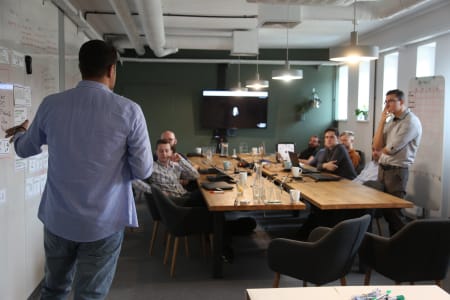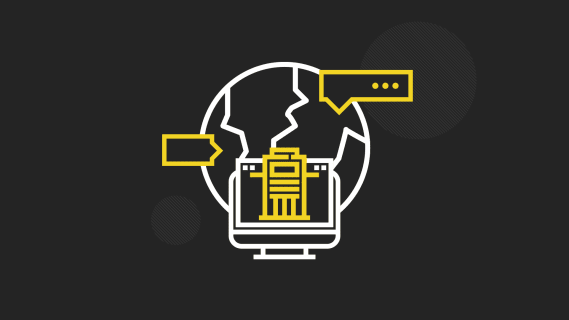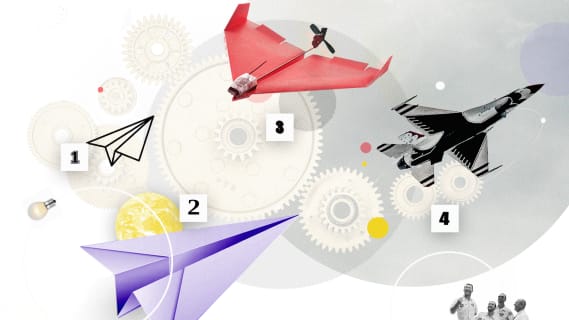Our New Normal toolkit
At Boldare, we help to create amazing digital products that answer the business needs of our partners. We are also passionate about Boldare as an organization and how it works. This is why we practice agile, the lean startup approach and scrum; what’s more, we switched to holacracy, and work with a system of radical transparency without managers. Today we want to share with you our toolkit - a list of tools and methodologies that we use (or used) during our journey to become a New Normal company. Read on to see our recommendations based on 16 years of operation, experience and discovering best practices the old-fashioned way: by doing and learning.

Table of contents
Online collaboration
Slack
Slack is an instant messaging platform, perfect for everyday communication between individuals and across the whole organization; it can be used to support asynchronous cooperation and radical transparency. It helps us to facilitate communication more efficiently, practically eliminating emails from our internal channels and has helped us to realize how much time can be saved by asking questions publicly instead of asking specific people using private messaging.
Pro tips:
- Set the transparency rules for all your Slack channels to be open, wherever possible.
- Using features like remainders and bots (including using the facility for automation to write your own bots - we have built several internal ones, e.g. to report on the financial health of Boldare on a weekly basis), Slack can help your people save time, work on metrics, even establish team rituals.
Google Meet
In a market full of video-conferencing/meeting tools, we’ve found Google Meet to be light, fast and efficient – perfect for collaborating across distance. What’s more, all you need is a browser and you’re good to go. Also, recently the tool was upgraded with many great features (background change among others) decreasing the gap with other popular video platforms. What’s more, compatibility with Google Calendar and other Google apps is a huge advantage.
Pro tips:
- Trust and transparency is important – to ensure a ‘level communication playing field’ in your meetings and online events, agree that in general, cameras are turned on all the time.
- Google Meet isn’t just for remote team meetings and other structured events. Use it for quick calls to handle day-to-day practical issues, too. We use all-time open calls for team members who want to work together or need to quickly chat about something important.
- Regular video calls can be part of creating a culture of closeness and psychological safety.
Visual collaboration
Mural
Mural describes itself as, “a digital workspace for visual collaboration.” For us, this means the capability for interactive facilitation of important meetings. It’s also a great tool to facilitate meetings with a greater number of participants who can actively take part in teamwork in one, shared virtual space.
Pro tips:
- Mural’s pre-set templates, tables and frameworks (such as lean canvas, force field analysis, wall of work, etc.) support data-gathering and facilitation of group decision making.
- Mural is good for engaging your team and stakeholders with complex ideas and processes. It allows us to conduct exercises that can help us to understand and organize large amounts of information.
Boldare Boards
Originally born from a desire to streamline scrum retrospective meetings, as the Sprint Retrospective Tool, Boldare Boards is a free online collaboration app for remote teams (you might guess from the name that it’s something we created ourselves!)
Pro tips:
- Boldare Boards can be used in any meeting or event in which you want people to share ideas and make decisions: sprint retrospectives, brainstorms, feedback sessions, and more.
- It can be used without the need to create an account, but you can log in via your Google account to save and organize your boards for later use.
Organizational roles & structure
Holaspirit
In terms of clarity or organizational structure and operation, Holaspirit is a kind of “holacracy in a can” platform. It enables everyone in your team to visualize what each person within the organization does, links your projects to your company purpose, includes streamlined templates for ‘out-of-the-box’ performance and helps to conduct holacratic meetings (tacticals or governance) according to an agenda.
Pro tips:
- It’s not necessary to be working within a holacracy framework to get the benefit - tactical meetings with their “tension” can be beneficial for all types of organizations.
- A clear picture of your structure of roles and responsibilities, and how they interact, helps you keep pace with the New Normal business environment. Especially if changes are a vital part of the organizational mindset, as they are in Boldare.
Management and organizational governance
Holacracy
Holacracy is a framework that you can use to embed business-focused autonomy and agility encoded into your organization’s DNA. The New Normal encourages self-organizing teams and organizations and Holacracy is a ready-to-use set of rules to support exactly that.
Pro tips:
- Holacracy helps drive your organization’s transition to being more distributed and self-organized. Thanks to this framework, it’s easier to face and get through unexpected challenges, like a COVID-19 pandemic.
- Metrics and planning are fundamental elements, supporting teamwork and ownership of goals and encouraging employees to make smart, data-driven decisions and… learn from mistakes.
- With holacracy, leadership is dispersed, encouraging shared responsibility across the teams.
Product management & collaboration
Asana
Remote teams need shared spaces to work in and that’s what Asana offers: a space focused on work and task management that can facilitate transparency and alignment of purpose in cross-functional teams.
Pro tips:
- Use Asana to take a broader view of task management, including shared or team-wide responsibilities, highlighting dependencies.
- Tasks can be structured around strategy instead of teams or departments, placing your strategy at the heart of your teamwork.
- Portfolios and their timelines are great features to track progress, even in complex projects.
Strategy & execution
OKRs
Objectives and Key Results is a collaborative goal-setting methodology, ensuring that everyone is working together, and in the right direction. Using OKRs, you can define and track objectives and dependencies.
Pro tips:
- Use OKRs to make more informed, data-driven decisions with appropriate input from the whole team. Objectives should be ambitious while being realistic at the same time, this is why they work better in organizations that are experiencing fast growth.
- OKRs can be embedded into other tools (like mentioned Asana), helping align all your efforts to the overarching business goals.
- It’s easy to confuse OKRs with KPIs, so if you want to monitor the status of vital targets (market share, ROI), use KPIs. If you want to set goals and indicate strategic directions (double the revenue, shorten time-to-market for your products), use OKRs.
Marketing & sales
Smarketing
Sales and marketing as separate functions is a setup that belongs in the past. A smarketing approach seeks to integrate the two collaboratively, with a common vision and processes that go far beyond the occasional joint meeting.
Pro tips:
- On a single prospect level, Smarketing requires closed loop reporting - this approach allows joint tracking of specific leads together.
- Collaboration is facilitated by shared metrics, based on the same funnel, and accessible by all.
- At Boldare, our Marketing and Sales teams share the same meetings and work on projects together on a daily basis.
Growth Hacking
Growth hacking is a philosophy that focuses your people on finding smarter and more economic digital marketing alternatives. Methods include smart use of social media, data-driven decision making, marketing automation, and viral marketing.
Pro tips:
- Cross-disciplinary working (such as software developers collaborating directly with the marketing department) are a crucial part of the cross-disciplinary team. Engineer presence in a marketing team helps to build data-driven culture and brings usage of metrics to a completely new level.
- Growth hacking techniques are a complement to classical marketing efforts, not a replacement. That said, whatever portfolio of techniques you adopt, they must be coordinated and aligned.
Performance
Burn down charts
Keeping track of performance is critical, especially in VUCA business environment. A burn down chart is a graph showing work remaining versus the project’s timeline, providing highly accurate estimates of when all work will be completed. Some tools, like Jira, use built-in features to create burn down charts.
Pro tips:
- While they are applicable to any project, burn down charts are particularly useful when working with an agile software development methodology.
- Burn down charts support the adoption of data-driven habits across the whole organization, by illustrating dependencies between current efforts and work that is left to be done.
Digital Product Development
Lean Startup
The lean startup approach is a set of tools and methods geared to rapidly validating (or invalidating!) your proposed business idea or model. While these principles can be usefully applied to almost any complex challenge scenario, they are most effective when used for digital product development.
Pro tips:
- When finishing or starting a business increment, teams should home in on best practices by asking themselves, “How can we learn more quickly what works, and discard what doesn’t?”
- A community underpinned by lean startup principles is naturally focused on problem-solving – all members of the community are potentially available to answer questions.
Scrum
The scrum framework supports collaborative creation of complex digital products. Scrum teams learn through experience, self-organize to solve problems, and are focused on evaluation and feedback for continuous improvement.
Pro tips:
- Make your teams interdisciplinary (e.g. include a marketing specialist, a usability-focused designer or UX content writer) for really innovative and business-aligned solutions.
- To maximize teams’ effectiveness and minimize communications issues, keep the teams no bigger than 9 members.
- Scrum can be scaled to handle highly complex team ecosystems, keeping them autonomous but also aligned. One of the ways to scale scrum is Nexus Scrum - we practice it with some of our clients to handle multiple teams working on several products at the same time. I describe Nexus in another part of this article.
Prototyping
With the New Normal driving digital transformation and digitization of products, deadlines and pressure are tighter than ever. The key to avoiding wasted development effort is to test your business ideas and hypotheses rapidly and efficiently – hence prototyping, that allows you to check if the idea is worth investing in, or not.
Pro tips:
- Prototyping can be used at every phase of the digital product development process, using simple, no code to low code solutions and tools, like UXPin or Invision.
- A prototyping team has a very specific role and focus. For maximum efficiency of operation, ensure the whole organization understands the prototyping function and that its role is not to build successful products but to test and learn lessons early in the development process (or pivot it, if the initial hypothesis is invalidated).
Design System
Your design System is effectively a branding manual or guide for your products’ visuals. It’s a single reference point for all your UX/UI design elements, ensuring that all your products have a consistent identity (i.e. they all look like they’re yours).
Pro tips:
- Use your design system as a bridge between product designers and developers, encouraging collaboration and mutual understanding.
- The components of your design system should allow you to build prototypes or MVPs to test new hypotheses, faster and more economically thanks to using pre-designed components. In turn, this allows you to respond rapidly to changing markets and priorities.
Microservices
The New Normal prizes flexibility and – in terms of digital products – scalability. Microservices give you both. By developing and utilizing single features that can be combined to create the overall product, microservices encourage an evolutionary model of development in which the individual features prove their worth and grow (or inspire further features) or attract few users and fall by the wayside.
Pro tips:
- To ensure the services are effective and functional, use domain-driven design to prevent misunderstandings between business units and DevOps teams during the development process.
- To keep your eye on the bigger picture, ensure the team has a common understanding of the level and purpose of the features (e.g. by using a tool such as event storming workshops that help team members to align their knowledge properly).
Innovation Accounting
Startups, by definition, have no history and therefore no prior performance to benchmark or use as the basis of metrics. Part of the lean startup approach, innovation accounting is a metric-building framework to enable you to measure performance objectively on three levels – user engagement with the product, assumption-testing, and current product value – even when you’re working on something without precedent.
Pro tips:
- For easier comparison and performance benchmarking down the line, you can use the same set of metrics for all your digital products.
- The use of innovation accounting metrics gives the whole team a clear and common focus: the value they are providing.
Digital Product Scaling
Nexus Scrum
When you’re scaling your product for a new or larger market how do you ‘keep things scrum’ when you’re working with multiple, connected products? Nexus is scrum for multiple products and development teams, adding an extra layer to the scrum methodology to ensure proper synchronization.
Pro tips:
- Once your people are familiar with scrum, they’ll find Nexus to be a natural extension, easily adapted to.
- Although Nexus carries a stated limit of nine scrum teams, the framework also allows for multiple nexuses in a single business, one for each digital product.
You need your own new normal toolkit!
You, and many others, are facing the New Normal, and that means new or changed markets, shifting user needs, and an increased emphasis on digitizing products and how users access them. That can be a tall order but at Boldare, we know from experience that the above set of tools, apps, frameworks and platforms can help you meet the challenges to come. Now, you can use this list as a cheat sheet, to build your own toolkit.
Share this article:











